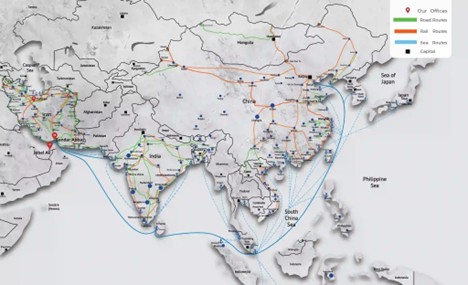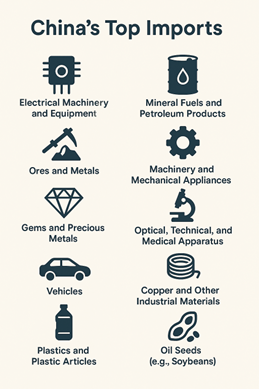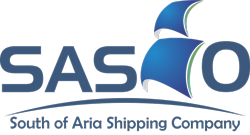
Major Shipping Routes From Iran to China
Several key shipping routes connect Iran to China, each offering unique advantages depending on cargo type, budget, and delivery time.
Sea Freight From Iran to China
Sea freight is the most widely used method for shipping from Iran to China, especially for bulk cargo. Goods typically depart from Iran southern ports like “Bandar Abbas” or “Chabahar” and arrive at major Chinese ports such as “Shanghai”, “Ningbo”, or “Shenzhen”. Although slower compared to other modes, sea freight is cost-effective and ideal for heavy shipments. Transit time usually ranges from 20 to 35 days, depending on route and vessel schedules.
Land Transport From Iran to China
Land transport offers faster delivery for regional or high-priority shipments. Trucks travel through northern Iran, cross Central Asia (often via Turkmenistan or Kazakhstan), and enter China through western provinces like “Xinjiang”. This method is suitable for time-sensitive goods but has volume limitations and may be affected by border regulations. It's a practical solution for companies prioritizing speed over cost.
Rail Freight From Iran to China: A Route on the Rise
While not yet operating at full scale, rail freight between Iran and China is on the verge of becoming a major logistics corridor. Strengthened by growing trade ties and infrastructure investments under the Belt and Road Initiative, this route is quickly moving toward practical implementation. Planned connections between key Iranian cities like Tehran and major Chinese hubs such as Xi’an and Chongqing are nearing completion.
Once fully operational, this mode of transport will offer a smart balance between speed and cost—faster than sea freight, more economical than air. It's set to become a preferred choice for mid-sized shipments that demand reliability, predictability, and efficiency.
Air Freight From Iran to China
Air freight is the fastest option for shipping from Iran to China, especially when speed is more important than cost. Cargo is typically flown from Tehran “Imam Khomeini International Airport” or other major Iranian airports to destinations like “Beijing”, “Guangzhou”, or “Shanghai”. It is commonly used for high-value, low-volume goods such as electronics, pharmaceuticals, or documents. Despite higher costs, delivery can take as little as 2–5 days.
Multimodal Transport From Iran to China
Multimodal shipping from Iran to China combines different shipping methods—like sea, rail, and road—to balance time, cost, and reliability. For example, goods may be trucked from Tehran to “Bandar Abbas”, shipped to a port in southern China, and then delivered inland by rail. This approach is often used when direct routes are limited or when flexibility is needed. It’s a smart solution for complex logistics and growing in popularity among exporters.

Key Ports and Border Crossings
Key ports and border crossings play a central role in facilitating trade between Iran and China by serving as the logistical backbone of cross‑border goods movement.
On Iran’s southern coast, Bandar Abbas—specifically the Shahid Rajaee port—handles around 90 % of the country’s container traffic and roughly 55 % of total exports, making it the primary maritime gateway for shipping from Iran to China (sainaexp.com).
Chabahar Port, situated on the Gulf of Oman, is Iran’s only deep‑water port and offers an alternative route that bypasses the congested Strait of Hormuz, increasingly important for access to Central Asia and China via the INSTC corridor.
On the land side, the Khorgos international border crossing between Kazakhstan and China serves as a fast-growing rail‑cargo gateway under the Belt and Road Initiative. In 2024, nearly 8,730 freight trains passed through, with customs processing times dropping to roughly 6–8 hours, enhancing efficiency in rail‑based logistics from Iran via Central Asia into China (railfreight.com). Together, these strategic ports and crossings form the critical nodes in the network used by exporters, freight forwarders, and logistics providers arranging shipping from Iran to China, whether by sea or rail.
Each of these Iranian ports and border crossings link to specific logistical hubs inside China. Bandar Abbas primarily connects by sea to eastern Chinese ports such as Shanghai, Shenzhen, and Ningbo, which serve as major entry points for maritime imports.
Chabahar Port facilitates multimodal transport routes through Central Asia, connecting to western China, including cities like Urumqi and Lanzhou, via road and rail networks, supported by the INSTC and complementary regional corridors.
Overland shipments passing through Central Asia often enter China via Khorgos, one of the world’s largest inland dry ports, which connects directly to Chinese rail hubs like Xi’an, Chongqing, and Chengdu—key nodes of the Belt and Road rail network.
To gain deeper insights into the logistics process, transportation strategies, and regulatory considerations, refer to our detailed guide: How to Manage Transport and Shipment to/from Iran in 2025 | Complete Logistics Guide.
Transit Times and Delivery Estimates for Shipping From Iran to China
The following table summarizes typical durations for shipping from Iran to China by different transportation methods.
|
Notes |
Average Transit Time |
Shipping Method |
|
Fastest option, ideal for small or urgent shipments |
2-5 days |
Air Freight |
|
Most economical for large shipments, dependent on ports |
22-35 days |
Sea Freight |
|
Faster alternative to sea, via Eurasian rail routes |
12–14 days |
Rail Freight |
|
Depends on route and road conditions |
variable |
Multimodal Transport |
Estimated Transit Costs from Iran to China
Shipping goods from Iran to China involves varying costs depending on the transportation mode. The following estimates provide a general overview of typical freight charges:
|
Mode of Transport |
Estimated Cost |
|
Sea Freight |
$1,500–$2,000 (20-foot container) $2,500–$3,000 (40-foot container) |
|
Air Freight |
$4–$8 per kilogram |
|
Rail Freight |
generally lower than air freight and faster than sea freight |
These figures represent standard market estimates and are subject to change based on fuel prices, geopolitical conditions, seasonal demand, and specific route agreements. Exporters are advised to consult with logistics professionals or freight forwarders for accurate, up-to-date cost calculations tailored to their shipping needs and trade strategies.
Required Documents for Transit of Goods through Iran to China
- Commercial Invoice: Details the transaction between the buyer and seller, including description, value, and quantity of goods. Must be issued by the supplier at the origin.
- Packing List: Provides a detailed breakdown of the shipment’s contents, including weight, dimensions, and packaging type.
- Bill of Lading (for sea) or Waybill (for road/rail): Acts as proof of shipment and contract of carriage, specifying the origin, destination, and carrier details.
- Certificate of Origin: Indicates the country where the goods were produced, issued by the exporting country’s chamber of commerce or equivalent authority.
- Transit Permit (Logical Permission): A specific permit issued by Iran’s Ministry of Industry, Mine, and Trade, required for goods transiting through Iran. This ensures compliance with Iranian regulations and is registered via the Comprehensive Trade System (https://www.ntsw.irhttps://www.ntsw.ir/).
- Customs Declaration: A detailed declaration submitted electronically via Iran’s Electronic Packing List (EPL) system, including shipment details and transit route through Iran.
- Insurance Policy: Freight insurance covering the goods during transit through Iran, typically Clause A, B, or C, issued by an Iranian insurance company or an internationally recognized provider.
- Border Quarantine Permit (if applicable): Required for goods like agricultural products or livestock to prevent disease spread, issued by Iranian authorities at the border.
Additional Considerations
- Customs Clearance Process: Goods transiting through Iran are subject to Iran’s risk-based assessment system (Green, Yellow, or Red channels). Green requires minimal inspection, Yellow involves documentary checks, and Red requires comprehensive inspection. Ensure all documents are complete to avoid delays in the Red channel.
- Prohibited Goods: Certain items (e.g., those banned under Islamic law or national security regulations) cannot transit through Iran. Verify the goods’ classification with Iranian customs.
- Transit Route: Common entry points include Bandar Abbas or Chabahar ports for sea-to-land transit, or land borders like Sarakhs for rail/road transit. Specify the route in the customs declaration.
Practical Tips
- Electronic Submission: Register all documents on Iran’s Comprehensive Trade System (https://www.ntsw.ir) before transit to streamline the process.
- Local Agent: Engage a local customs broker or logistics provider like SASCO to handle documentation and navigate Iran’s customs procedures efficiently.
- Timing: Submit documents well in advance, as processing (especially for Red channel goods) may take time. Allow 4–7 business days for standard processing.
China's top imports
China, as one of the world’s largest economies and manufacturing powerhouses, imports a vast range of goods to fuel its industrial production, technological development, and consumer markets. The country’s top imports reflect both its domestic consumption needs and its role in global supply chains.
Electrical Machinery and Equipment
At the top of China’s import list are electrical machinery and equipment, including semiconductors, integrated circuits, and components essential for consumer electronics, telecommunications, and automation industries. These imports support China’s leadership in manufacturing and technology.
Mineral Fuels and Petroleum Products
China is one of the largest importers of crude oil, liquefied natural gas (LNG), and coal. These energy resources are crucial for powering its industries, transportation networks, and growing urban centers. Countries like Russia, Saudi Arabia, and Brazil are key suppliers.
Ores and Metals
To support its massive construction and industrial sectors, China imports large volumes of iron ore, copper, aluminum, and other metals. These raw materials are vital for infrastructure projects, housing, electronics, and vehicle manufacturing.
Machinery and Mechanical Appliances
In addition to producing machinery domestically, China imports specialized industrial equipment and advanced machinery components from countries like Germany, Japan, and South Korea to enhance its manufacturing capabilities.
Gems and Precious Metals
China imports diamonds, gold, and other precious materials to meet demand in the jewelry market, investment sectors, and industrial applications.
Optical, Technical, and Medical Apparatus
High-precision instruments, including those used in healthcare, laboratories, and scientific research, are another key import category, reflecting China’s focus on technological advancement and medical innovation.
Vehicles
Despite having a booming automotive industry, China imports premium vehicles and automotive parts, especially from Germany and Japan, catering to high-end consumer demand.
Plastics and Plastic Articles
Plastics, including raw resins and finished plastic goods, are essential for manufacturing packaging, electronics, and consumer products, leading to significant imports from countries with strong petrochemical industries.
Copper and Other Industrial Materials
Refined copper, copper scrap, and other industrial materials are imported to support electronics, infrastructure, and machinery manufacturing.
Oil Seeds (e.g., Soybeans)
China is the largest importer of soybeans globally, using them as animal feed and for edible oil production. Brazil and the U.S. are key suppliers, meeting the needs of China’s massive food and agriculture sectors.
Reliable Freight Forwarder For Shipping from Iran to China
An Iran - China freight forwarder can make or break your shipping experience. When shipping from Iran to China, you need a logistics partner with regional expertise, reliable networks, and a deep understanding of customs procedures. SASCO stands out as a trusted name in Iran’s freight industry. With decades of experience, they offer tailored solutions for sea, land, and rail transport, along with full documentation and clearance support.
Whether you’re handling bulk cargo or specialized goods, SASCO ensures timely and secure delivery across key Chinese ports and inland hubs. For affordable Cargo from Iran to China, SASCO is a smart choice.
For a broader understanding of the shipping process, regulations, and logistics providers, see our comprehensive guide: Overview of Freight Forwarding in Iran.
FAQ: Shipping from Iran to China
Does Iran sell oil to China?
Yes. Despite international sanctions, Iran continues to export crude oil and petroleum products to China, which remains one of its largest buyers.
How much does it cost to ship to China?
It depends on the shipping method—air is usually more expensive, sea is cheaper for bulk. Costs vary by weight, volume, and route.
How long does it take to ship from Iran to China?
Transit times depend on the transport method:
- Air freight: 2–5 days
- Rail freight: 12–14 days
- Sea freight: 22–35 days
- Multimodal: Varies based on route and cargo
How to ship to China from Iran?
To ship from Iran to China:
- Choose a freight forwarder experienced in Iran
- Prepare required documents (invoice, packing list, etc.)
- Select the best transport method (sea, air, rail, or multimodal)
- Ensure customs compliance on both sides
- Track your shipment until final delivery







